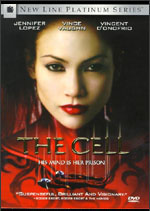
CELL, THE
Reviewed May 13th, 2001 by Todd Terwilliger
The first words that come to mind when thinking about Tarsem Singh's The Cell is eye-candy. The film is full of it. The Cell boasts some of the most creative uses of CGI yet seen on the big screen. However, scratch the dazzling surface and beneath, surprisingly, is a frustratingly ordinary movie.
The story follows the Silence of The Lambs archetype. Jennifer Lopez is Catherine Deane, a psychotherapist working with children via a new technology that allows Deane to enter the children's subconscious, much like a dream. When a suspected serial killer, Carl Stargher (Vincent D'Onofrio) goes catatonic, Deane is recruited by the feds to enter his mind and discover the location of his latest victim who, the feds believe, may still be alive.
The twisted world of Stargher's mind is visually incredible. Unfortunately, the film does not give it enough time to fulfill it's potential. Also, there seems to be no interior logic to the hodge-podge of fantasy and memory. Much like Clarise Starling had Hannibal Lector, Deane has Stargher's mind. They both fulfill the same purpose: to reveal necessary information at the price of self-truth and the risk of self-destruction. Unfortunately, while Lector has the proverbial method to his madness, Stargher's mind does not.
Lopez is adequate as the hero, Deane. D'Onofrio is the standout here as Stargher, especially the Emperor Stargher character. Vince Vaughn has a small role as an FBI guy who is piecing together the problem from the outside (i.e. the real world). He, like Lopez, is solid but not outstanding.
If The Cell shines anywhere, it is in its special effects. The New Line disc does a good job of preserving these effects on the small screen. The 2.35:1 anamorphic transfer is relatively clean and sharp. The bright color palette retains its vibrancy. Blues, reds, and blacks are all deep and full. There are some noticeable edge enhancements, as well as grain in some of the effect shots, that are not quite distracting. Overall, the transfer is nice, if not faultless.
The Dolby Digital soundtrack is well done. Though this film is not a wordy film, dialog is clear and locked in the central channel. There is some movement in the front soundstage. The rears are used almost exclusively for ambient sounds and the score.
New Line has put together a nice selection of special features for this edition. There are commentaries by director Singh and the production crew. The Singh commentary is interesting for the insight on his process while the production commentary is more about the technical details of the film. Also on the disc is an original making-of documentary, deleted scenes, a brain map and empathy test, production notes, and an isolated score track.
My main issue with The Cell is that it doesn't know what kind of film it wants to be: a thriller or a fantasy. Half the film is spent going through the motions of a conventional thriller while the other half is spent in the surreal environs of the subconscious. The old saying, “You can't please all the people all the time”, comes to mind. By refusing to commit solely to one type of film, The Cell fails to succeed as either one. However, once it gets going, The Cell is visually dazzling. Several scenes are seriously creepy while others invoke an otherworldly wonder and majesty. Director Singh cut his teeth on music videos and this heritage shows. He's created a visually arresting film that is a beautiful but, ultimately, shallow experience.
Please help support our site by buying this DVD title
through this link. Thank you
kindly.
|


 Purchase
This DVD Purchase
This DVD
Story / Content

Audio

Video

Extras

|